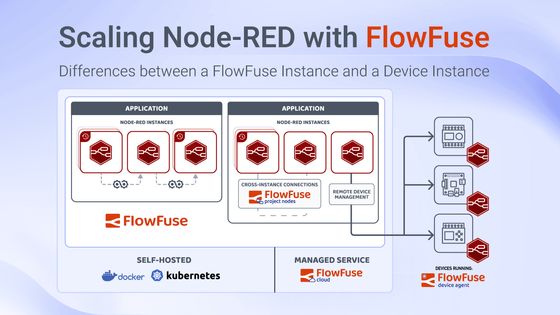Scaling Node-RED with FlowFuse: Differences between a FlowFuse Instance and a Device Instance
Managing your Node-RED instances is easier with FlowFuse.

FlowFuse is a Software as a Service (SaaS) platform designed to enhance the experience and capabilities of Node-RED for its users. By focusing on scalability, security, and Dev Ops, FlowFuse aims to remove some of the technical barriers associated with using Node-RED, making it easier for citizen developers to automate tasks, process data, and create applications. In this blog post, we will discuss the differences between a FlowFuse instance and a FlowFuse device instance while highlighting how FlowFuse addresses scalability challenges in Node-RED deployments.
Scalability Challenges with Traditional Node-RED Deployments
While deploying Node-RED is quite simple, managing multiple instances across different environments can become complex and time-consuming. As the number of devices and use cases grow, users face difficulties in scaling their Node-RED applications efficiently to handle increased load without compromising performance or security. This is where FlowFuse comes into play.
The Role of FlowFuse as an Orchestration Tool
FlowFuse functions as an orchestration tool that allows the deployment and management of all your Node-RED instances at scale, addressing scalability challenges head-on. By leveraging its platform, users can quickly deploy and manage multiple Node-RED instances while ensuring optimal performance and security. This enables them to connect with a wide range of devices, from PLCs and sensors to legacy software, without worrying about the complexities of managing their Node-RED deployment.
Deploying Node-RED Next to Devices
One common issue in IoT deployments is that device instances of Node-RED often communicate with unsecure devices or networks. To mitigate security risks and ensure data protection, it's common to deploy Node-RED in close proximity to these devices. The FlowFuse platform uses device agents that communicate back to the platform via a reverse tunnel over port 443. This setup requires only one firewall rule: allowing outbound connections from the device agent running Node-RED to the FlowFuse platform, significantly minimizing security risks while enabling remote monitoring, flow editing, and configuration deployment at scale.
Deploying Node-RED Instances Within the FlowFuse Platform
Not all instances of Node-RED need to be deployed at the edge and can be deployed anywhere. FlowFuse offers this flexibility in cases where users prefer or require deploying their Node-RED instances within the platform itself. This capability allows users to focus on developing and managing their applications without worrying about the underlying infrastructure.
Conclusion
FlowFuse addresses scalability challenges in Node-RED deployments by providing an easy-to-use platform that enables users to manage multiple instances at scale while maintaining security and performance. By understanding the differences between a FlowFuse instance and a device instance, you can make informed decisions about your deployment strategy and leverage the full potential of Node-RED for your applications. Stay tuned for our upcoming blogs where we will dive deeper into the areas of security, dev ops, and backup solutions provided by FlowFuse.
Recommended Articles:
- What is TEEP? Calculation, Benchmarks & TEEP vs OEE (2026)
- FlowFuse 2.25: Interacting with MCP Resources in FlowFuse Expert, Improved Update Scheduling, and lots of UI improvements!
- MQTT vs Kafka: Complete Comparison Guide 2026
- Node-RED Buffer Parser Guide: Decode Modbus and Industrial Device Data
- Building a Weather Dashboard in Node-RED